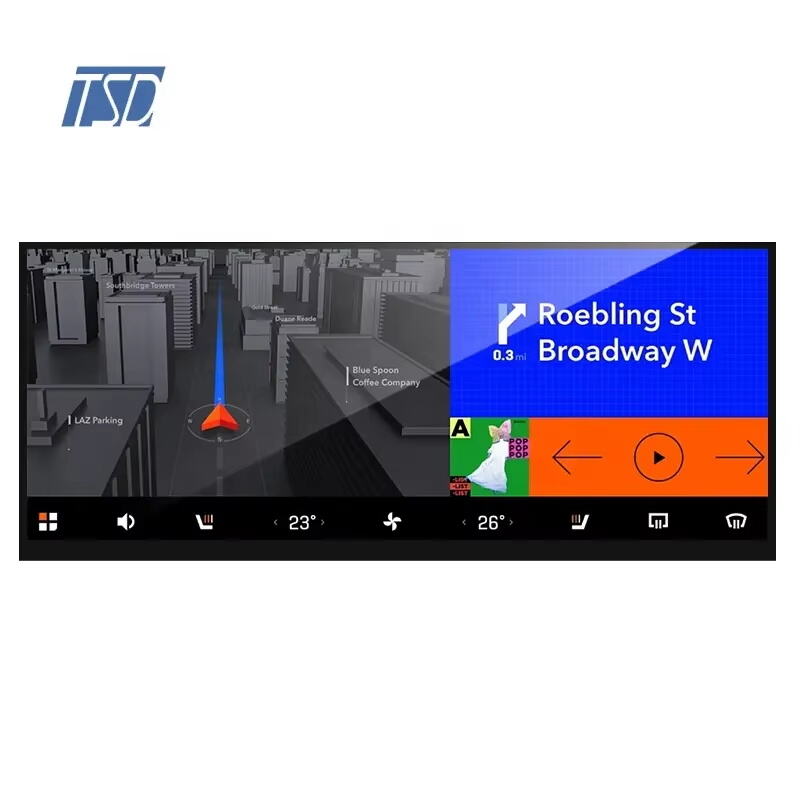The Growing Role of LCD Modules in Modern Vehicles
From Analog to Digital: The Shift in Automotive Interfaces
When cars started switching from those old fashioned round gauges to digital screens, it was pretty much a game changer for how people drive today. The digital stuff just gives way better accuracy and lets drivers interact with all sorts of features that weren't possible before. Traditional speedometers and fuel gauges are pretty limited compared to what modern dashboards can do these days. Car manufacturers have noticed this trend too. According to market research, most new car shoppers actually prefer digital displays now. We've seen this happen pretty fast over the last ten years or so. Luxury brands like Mercedes and BMW were early adopters, but even budget friendly models from Ford and Toyota come with decent digital dashboards nowadays. Beyond looking cooler inside the car, these screens help keep drivers safer because they show important information right where it matters most without distracting them from the road ahead.
LCD Modules as Core Components of Smart Cockpits
LCD screens have become essential for creating smart car dashboards, bringing together all sorts of connected features, entertainment options, and GPS systems right inside vehicles today. What was once just a basic dashboard is now turning into an interactive space where drivers can get all kinds of info at their fingertips. Big name car manufacturers are pouring money into developing better LCD tech to keep customers engaged while driving and offer those fancy in-car experiences people want nowadays. Take LG Display and BOE Technology Group for instance they're really pushing boundaries with their LCD panels that deliver crystal clear images while consuming less power, something we're starting to see across many new car models hitting showrooms. With cars looking more like tech centers than ever before, these LCD components remain crucial building blocks for the future of intelligent vehicle design, ticking boxes for what consumers expect and keeping pace with evolving industry requirements for next generation cockpit setups.
Trend 1: Larger and Curved Display Innovations
Panoramic Dashboards and Pillar-to-Pillar Designs
Panoramic dashboards have become something of a revolution in cars lately, really changing how drivers and passengers interact with their vehicles. The big flat screens stretch across the dashboard without any breaks, giving folks a much better view of all the info they need while driving. Car companies are seeing this as a win because it looks sleeker too. People want their cars to feel modern these days, so there's been a real push towards touchscreens and easy-to-reach controls throughout different types of vehicles. Market research shows that folks aren't just buying luxury models with giant screens anymore either. Even regular family sedans and trucks now come standard with bigger displays. Drivers seem to crave that connected feel inside their cars, wanting everything at their fingertips during those long commutes or road trips.
OLED vs. TFT-LCD: Balancing Aesthetics and Functionality
The ongoing discussion about OLED versus TFT-LCD tech is still pretty hot stuff in the automotive display world. OLED screens definitely win points for those amazing colors and those deep black levels that just pop, though they do cost a lot more money and struggle with brightness compared to other options. The TFT-LCD side of things tells a different story altogether. These displays are generally cheaper to produce and lately have gotten some serious upgrades that boost their brightness and cut down on power consumption, which matters a lot in cars where sunlight can wash out screens and battery life counts. With continued improvements in TFT-LCD technology, these displays are starting to catch up fast. Many carmakers now see them as a solid middle ground solution when trying to balance looks with practical features for today's vehicles.
Trend 2: High-Resolution Touchscreen Integration
4K and 8K Resolution Standards in Automotive LCDs
Bringing 4K and even 8K resolution to car LCD screens is changing how people interact with their vehicles inside those four wheels. These super sharp displays make everything from GPS maps to movie watching much clearer than before. Car companies know this and are jumping on board fast because customers want better looking screens nowadays. Take Mercedes and BMW for example both have started putting these fancy high res displays in many of their models lately. What does this mean? Drivers get easier to read maps while navigating busy cities, passengers enjoy watching videos without pixelated images during long road trips. The whole atmosphere inside modern cars just feels more premium when the tech looks this good.
Haptic Feedback and Gesture Control Advancements
New developments in haptic feedback tech are changing the way people work with car dashboards, creating interfaces that feel more natural and keep drivers safe. When there's haptic feedback, the dashboard actually gives back some physical sensation so operators can tweak settings without taking eyes off the road ahead. Alongside these improvements comes gesture control tech that's gaining popularity fast. With just a wave of the hand or two fingers moving across space, folks can adjust climate settings or change music tracks while keeping both hands on the wheel. Industry insiders predict we'll see lots more cars coming equipped with gesture recognition features soon because they offer smoother interactions overall. As manufacturers continue down this path, we might start seeing completely different approaches to what our vehicles look like inside, all focused around making driving experiences better for real world usage scenarios.
Trend 3: Energy-Efficient LCD Technologies
Low-Power Consumption Designs for EVs
Car manufacturers are really getting serious about those low power LCD screens in their electric vehicles lately. They want to make cars run better on smaller batteries basically. Some research out there indicates these new LCD tech options actually cut down on power usage around 30% when compared to what was used before. That means batteries last longer between charges which everyone loves. Big names in the car world including Tesla and Toyota have started pouring money into this stuff because it gives them two good things at once improved efficiency plus customers get to drive further without stopping so often. Makes sense really given how green the whole sector wants to appear these days.
AMOLED Adoption in Hybrid Vehicle Displays
The AMOLED tech we see in smartphones is now making waves in hybrid cars thanks to those great contrasts and power savings. For hybrids that constantly juggle between battery power and gas engines, this kind of display tech really helps manage energy better. Big names like Toyota and Hyundai are already putting AMOLED screens in their newer hybrid models. They mention brighter colors and less drain on the battery as main selling points. Drivers get nice visuals on dashboards without sacrificing fuel economy, which matters a lot when trying to keep those hybrids running efficiently day after day.
Trend 4: Ruggedized LCD Modules for Extreme Conditions
Wide Temperature Range Operation (-40°C to 105°C)
LCD modules built to handle extreme temperatures play a vital role in keeping displays functional when conditions get tough, particularly in rugged environments like off-road vehicles and specialized machinery. The ability to work across significant temperature swings makes them indispensable for situations where weather can change dramatically from one moment to the next. Industry professionals point out that this temperature resilience really strengthens how long displays last and how dependable they remain even when exposed to rough treatment. For sectors that rely on equipment working no matter what Mother Nature throws at it, these features become absolutely necessary. Think military field operations, heavy manufacturing plants, or any location far removed from controlled indoor settings where standard displays would simply fail.
Anti-Glare and Anti-Reflective Surface Treatments
Adding anti-glare coatings and anti-reflective treatments to LCD module surfaces makes them much easier to see in all sorts of lighting situations. This matters a lot outdoors when bright sunlight hits the screen and washes out what's being displayed, which can be dangerous in certain contexts. Studies have shown that screens with these special treatments help people read better, reduce tired eyes after prolonged viewing, and generally match what consumers want from their displays these days. Take car dashboards as an example. Vehicles used regularly in places like Arizona or Florida need these features badly so drivers don't struggle to read speed, fuel levels, or navigation info while driving down the highway on a blazing hot day.
Trend 5: ADAS-Integrated LCD Systems
Augmented Reality Windshield Projections
The latest augmented reality windshields are changing how we stay safe behind the wheel. These smart glass systems put important stuff right where drivers need to see it, making them more aware of what's going on around them. When navigation directions, warning signs about road hazards, and current speed limits appear directly on the windshield, it creates a much safer driving situation overall. Research indicates that people who use these kinds of heads-up displays tend to get into fewer accidents. According to one study cited by health experts, vehicles equipped with AR technology actually reduce front collisions by roughly 30 percent compared to traditional setups. That kind of improvement makes sense when considering how much easier it is for drivers to process information without taking their eyes off the road.
Collision Warning Visualization Techniques
LCD systems are really important when it comes to giving drivers those real time warnings about collisions happening around them, which helps everyone stay more aware of what's going on while driving. When car manufacturers hook up these fancy sensors to the LCD screens inside cars, they can show drivers cool 3D visuals of things that might be dangerous nearby, letting them know something bad could happen pretty quickly. According to numbers we've seen from NHTSA, these kinds of warning systems actually do seem to make roads safer by reducing accidents overall. Some research even suggests that rear end crashes drop by as much as 23 percent where these systems are used regularly. And let's not forget how fast people react when they see those visual alerts pop up on their dashboards during emergencies, which definitely makes our highways a lot safer place for everyone involved.
FAQ
What are the main benefits of converting analog displays to digital displays in vehicles?
Digital displays offer greater precision and interactivity compared to traditional analog dials, enhancing driver experience and safety by providing real-time data more intuitively.
How are LCD modules transforming vehicle interiors?
LCD modules enable the integration of connectivity features and infotainment systems, creating smart cockpits that enhance in-car experiences with high-resolution and energy-efficient displays.
Why are panoramic dashboards becoming popular in vehicles?
Panoramic dashboards provide a wide, uninterrupted field of view, enhancing aesthetics and functionality. They cater to the growing consumer demand for ergonomic design and touchscreen interfaces.
How do ruggedized LCD modules benefit off-road vehicles?
Ruggedized LCD modules are designed to operate under extreme conditions, maintaining display performance across diverse climates and terrains, crucial for off-road and specialty vehicles.
Why is augmented reality in windshields important?
Augmented reality windshields project critical driving information directly onto the display, reducing driver distraction and enhancing safety by providing intuitive information at a glance.
What are the energy efficiency advancements in LCD technologies for EVs?
Modern LCD technologies feature low-power consumption designs, reducing energy usage by up to 30% compared to traditional models, crucial for enhancing the efficiency of electric vehicles.
Table of Contents
- The Growing Role of LCD Modules in Modern Vehicles
- Trend 1: Larger and Curved Display Innovations
- Trend 2: High-Resolution Touchscreen Integration
- Trend 3: Energy-Efficient LCD Technologies
- Trend 4: Ruggedized LCD Modules for Extreme Conditions
- Trend 5: ADAS-Integrated LCD Systems
-
FAQ
- What are the main benefits of converting analog displays to digital displays in vehicles?
- How are LCD modules transforming vehicle interiors?
- Why are panoramic dashboards becoming popular in vehicles?
- How do ruggedized LCD modules benefit off-road vehicles?
- Why is augmented reality in windshields important?
- What are the energy efficiency advancements in LCD technologies for EVs?




